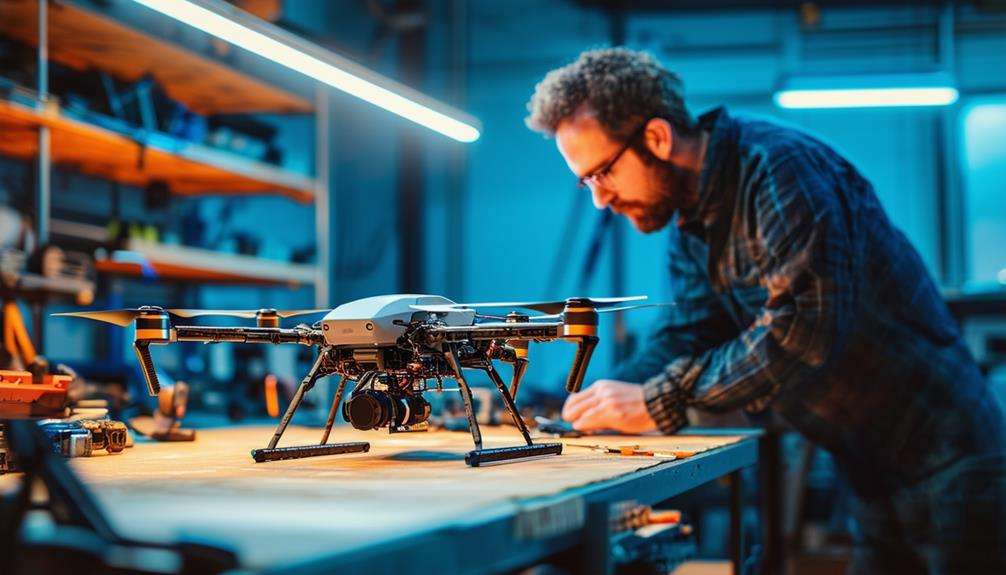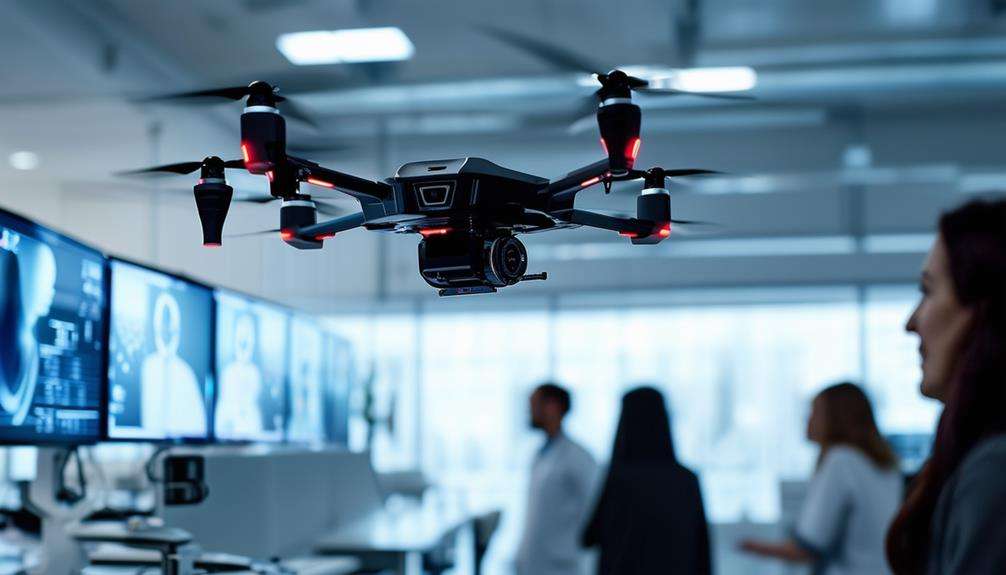What Is a Drone Docking Station?

A drone docking station is an essential tool for autonomous drone operations, enabling UAVs to take off, land, and recharge automatically. You don't need much human intervention since these stations handle tasks like battery swapping and data processing. They're weather-resistant, making them reliable in various conditions, and they support BVLOS missions, which is great for remote surveillance or agriculture. With edge computing integration, you get real-time data processing right at the source. These features make them vital for industries like public safety and infrastructure. There's more to discover about how they transform drone usage and efficiency.
Key Takeaways
- A drone docking station facilitates safe takeoff, landing, and recharging of UAVs with minimal human intervention.
- It supports autonomous operations, particularly for Beyond Visual Line of Sight (BVLOS) missions.
- The station includes automated battery swapping for extended UAV operation.
- It features weather-resistant designs to ensure reliable operations in various environmental conditions.
- Integration with edge computing allows real-time data processing and workflow integration.
Understanding Drone Docking Stations
When it comes to optimizing drone operations, understanding drone docking stations is crucial. These stations are essential for the safe takeoff, landing, and recharging of unmanned aerial vehicles (UAVs), including both multirotor and eVTOL drones. By incorporating automated capabilities, drone docking stations enable autonomous drone operations, especially for missions that require Beyond Visual Line of Sight (BVLOS). This allows for cost-effective monitoring solutions, such as those used in agriculture and infrastructure inspections. This means you can conduct complex tasks without needing direct visual monitoring, enhancing efficiency and expanding operational range.
The weather-resistant designs of these stations ensure they can withstand various environmental conditions, from extreme heat to freezing cold. This reliability is vital for maintaining consistent drone operations, no matter the weather. Docking stations also integrate with edge computing systems, allowing real-time data processing and seamless integration into existing workflows.
Key Features and Functions
How do drone docking stations transform UAV operations into efficient, autonomous systems? They streamline the takeoff, landing, and recharging processes, minimizing the need for human intervention. By doing so, these stations elevate the capabilities of autonomous UAVs, making them vital tools in various sectors. For instance, public safety agencies can deploy drones for critical tasks like surveillance and mapping without manual oversight, thanks to these advanced docking solutions. In 2024, commercial adoption of drones is rapidly increasing, with a significant impact on sectors such as logistics, agriculture, and construction. Key features of a drone docking station include automated battery swapping and real-time data processing, which ensure that UAVs remain operational for extended periods. Stations like the DJI Dock 2 also boast IP55 ingress protection, providing durability and reliability in challenging weather conditions. This robustness is crucial for maintaining consistent operations, particularly in time-sensitive missions. Advanced docking stations support BVLOS (Beyond Visual Line of Sight) operations, expanding their applicability to intelligence, surveillance, and reconnaissance (ISR) activities. Moreover, models like the Hextronics Global Advanced offer rapid refueling capabilities, making drones ready for action in under five minutes. These features collectively enhance the efficiency and autonomy of UAV operations, proving indispensable for organizations requiring swift and reliable aerial support.
Types of Drone Docks

Drone docking stations unlock new dimensions in UAV efficiency through their innovative designs and functionalities. When considering the types of drone docks, you've got a few exciting options. Automated drone stations, for instance, eliminate the need for constant human intervention. They enable Beyond Visual Line of Sight (BVLOS) missions, making them perfect for tasks like ISR and mapping. These docks enhance operational capabilities by reducing manual oversight.
You'll also find mobile and fixed drone ports. Mobile docks, such as those with self-leveling landing pads, are ideal for naval vessels, ensuring a smooth landing even at sea. Fixed stations offer stability and precision, crucial for accurate landings in permanent settings.
Weather-resistant designs are another critical feature. Models like the Hextronics Atlas M300 operate in extreme temperatures from -30°C to +65°C, maintaining reliability regardless of the weather. Meanwhile, systems like Hextronics Global Advanced utilize robotic battery-swapping technology for rapid refueling, allowing drones to be fully refueled in under five minutes.
Additionally, advanced drone docks, including the DJI Dock, seamlessly integrate automated charging systems, ensuring drones are always ready for their next mission. These features collectively ensure maximum uptime and efficiency.
Automation and Technology
In recent years, automation and technology have revolutionized drone docking stations, enhancing their capabilities and efficiency. By reducing the reliance on human pilots, these stations enable drones to autonomously take off, land, and recharge without direct human intervention. This level of autonomy is made possible by advanced technology like precision landing systems, which use computer vision and RFID to ensure accurate docking and deployment.
Cloud connectivity is another key feature, allowing real-time data processing and remote management of drone operations through 4G/5G/LTE networks. This connectivity ensures that you can monitor and control your drones from virtually anywhere, making operations more streamlined and efficient. Edge computing plays a crucial role here, offering immediate data analysis and decision-making during drone missions. It improves responsiveness and operational capabilities by processing data locally, reducing latency and dependence on centralized data centers.
Moreover, some docking stations come equipped with integrated environmental monitoring systems. These systems provide up-to-date weather conditions, significantly enhancing operational safety and efficiency. By leveraging these technological advancements, drone docking stations have become critical components in modern drone operations, allowing you to optimize performance and safety in various applications.
Leading Products and Brands

Exploring leading products and brands in the drone docking station market reveals a diverse range of innovative solutions designed to meet various operational needs. DJI Docks, like the DJI Dock 2, offer a lightweight and compact option with IP55 ingress protection, supporting Matrice 3D and 3TD drones. With a maximum effective operating radius of 10 km, it's perfect for extensive drone operations.
The Hextronics Global Advanced Drone Station stands out with its rugged, weather-resistant design, capable of handling extreme temperatures from -20°C to +50°C. What sets it apart is its autonomous battery swapping feature, ensuring continuous operation without manual intervention. For those using the DJI M300 series, the Hextronics Atlas M300 is ideal, accommodating up to 8 batteries and achieving quick battery swaps in under 90 seconds.
If you're looking for a solution with enhanced security features, consider the IDIPLOYER Nexus. Its lightweight insulated aluminum body offers a 45-minute charging time, along with internal and external CCTV and a tamper alarm with GPS. Meanwhile, the Heisha D80 (PRoC) is a modular option, designed for versatility, compatible with various drone models, and operates efficiently in temperatures between -20°C and +50°C.
Industry Trends and Innovations
The drone docking station market is undergoing a transformative shift towards fully autonomous operations, significantly reducing the need for human intervention in drone management. This evolution is driven by innovations in drone docks that allow drones to independently recharge and manage their operations. You'll find that lightweight and portable drone docks are becoming increasingly popular, offering versatile deployment options across various environments and applications. This flexibility is crucial for sectors like public safety and logistics, where the demand for efficient and reliable drone services is growing rapidly.
Industry partnerships are playing a pivotal role in fostering advancements in drone technology. Collaborations between tech companies and logistics firms are leading to improved efficiency and enhanced functionalities in docking systems. These partnerships are crucial for addressing the challenges of battery management and expanding operational ranges, making drone docks more reliable for continuous operations. Recent innovations focus on these areas, ensuring that drones can operate longer and more effectively without frequent human oversight. As the market evolves, you can expect drone docking stations to become an integral part of automated logistics solutions, driving further innovations that enhance their capabilities and widen their applications.
Operational Benefits

When it comes to operational benefits, drone docking stations revolutionize how drones function by enabling fully automated missions that minimize the need for human pilots. With companies like DJI at the forefront, these docking stations allow unmanned aerial vehicles (UAVs) to perform tasks with remarkable efficiency. By supporting Beyond Visual Line of Sight (BVLOS) missions, drones can operate over greater distances and in diverse environments, opening up new possibilities for applications like ISR (Intelligence, Surveillance, and Reconnaissance) and mapping.
Docking stations come equipped with features like fast charging and built-in backup batteries. This ensures your drones can quickly return to the air, maintaining operational readiness even during power outages. Moreover, the integration of edge computing systems enables real-time data processing, which significantly enhances the responsiveness and decision-making capabilities of UAVs. This means your drone operations are not only faster but smarter.
Additionally, these stations provide robust protection from environmental factors and theft, ensuring that both drones and their accessories are secure and ready for deployment whenever needed. The result is a seamless, autonomous operation that optimizes the performance and longevity of your UAVs, making drone missions more effective and reliable.
Starting a Drone Program
Starting a drone program can seem daunting, but with the right preparation, it becomes a manageable and rewarding endeavor. First, research local drone laws and regulations to ensure your operations comply with aviation authorities. This will provide information needed to avoid legal setbacks. Once you're clear on the legalities, choose equipment that aligns with your program's goals. Consider drone ports and docking station compatibility, as well as whether the drones can withstand harsh weather conditions, especially if you're executing missions programmed for outdoor environments.
Next, focus on operator training. Proper training is essential for safety and efficiency. Ensure your team understands drone operation, maintenance, and emergency protocols. This knowledge is crucial, particularly when dealing with commercial drones that may conduct complex tasks. Clear program objectives will guide your operations, whether they're for commercial, public safety, or industrial applications.




